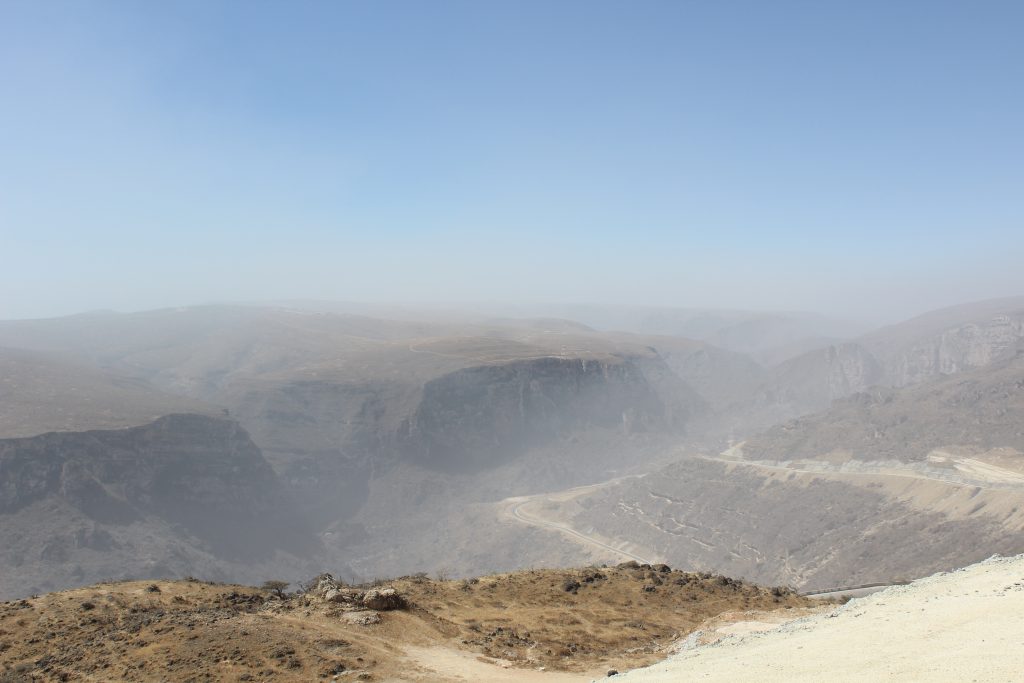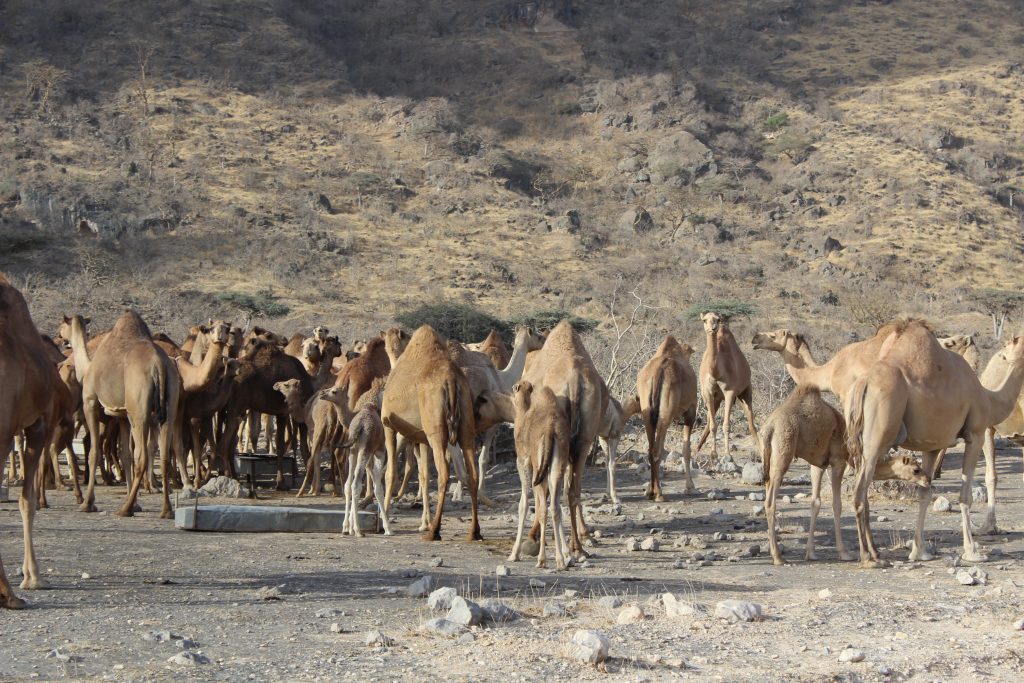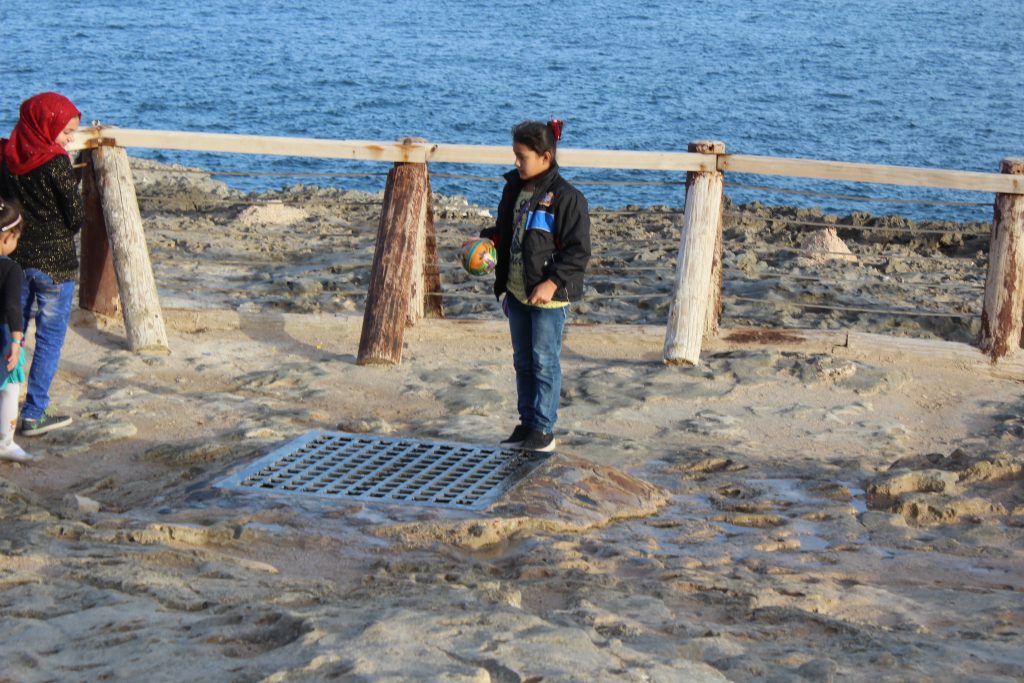Today was the big day to explore south of Salalah, and see if I would be able to put a foot, nay, a toe, in to Yemen. I woke up early to get my things in order, print the Qatar Airways boarding passes (QR let’s you check in 48 hours in advance, so I was able to get both the passes for both flights), finish some writing and work, do yoga, and be ready by 10AM. My guide was waiting for me a few minutes early, so I headed downstairs and checked out.
He had a white Nissan sedan and was wearing the traditional Omani dress with a wonderfully colorful keffiyah. He introduced himself as Mohammed (another one!), but that’s no surprise since such a high percentage of Islamic men are named Mohammed or some variation (Mahmoud, etc.). Incidentally, I tried to do some research on exactly what %, but I couldn’t find the answer. It feels in the range of 60% to me.
He explained the plan to me of heading south of Salalah to start out with, and I suggested we stop by the mosque first since it closed at 11AM. Even though it was not part of the plan, he was very agreeable and we were able to fit it in. Mohammed’s English was effective but not amazing, leaving a little to be desired in the form of detailed descriptions and facts about places. But what he lacked there he made up in friendliness, energy, curiosity, and charisma.
The mosque visit was brief and all business. It had the Sultan Qaboos name attached to it but it really wasn’t as grand as the one in the capital city of Muscat. Still, I got some nice shots despite the fact they were washing the courtyard due to the dust and wind storms.




Mohammed was kind enough to pick up some free pamphlets for me on Islam, and when we looked at them more closely in the car, it turns out that they were in every language but English – including Russian and Spanish.

After the mosque, we headed south of Salalah and left the dusty city behind. It was slow going and a little treacherous through the windy (and windy) mountain roads. One wrong move and you’d be right over the cliff, like on this “zig zag” road.

South of Salalah – zig zag mountain road
Our route would take us south of Salalah to Mauhsayl Beach, then to Dhalkut/Deem, and finally to the border with Yement in Sarfayt where Mohammed is from and lives.

South of Salalah Map
We stopped at many places a long the way to try to take nice pictures of the mountains and ocean, but it was so windy and dusty all the views were unfortunately obscured. Mohammed said that this was not the right time to visit, and then the best time was September, after the monsoon.

The ocean was not even visible at all.

We stopped at a snack shop along the way and picked up some sunflower seeds and pistachios mid-morning to curb our hunger as we continued South of Salalah to the border with Yemen in Sarfayt.
Since this was Mohammed’s hometown, he knew all the army men manning the checkpoints and the border. This local knowledge was in fact clutch to making the trip successful. At our first military checkpoint, where everyone is stopped, we had to provide our IDs (his license, my passport). Then, Mohammed was required to give the registration of the car. Unfortunately, the car wasn’t his (it belonged to the Safari Tour office), and the office had forgotten to put it in the car. There was a back and forth but eventually, because Mohammed was a known quantity, they let us through. At every checkpoint they recorded our names to make sure we reached the next checkpoint and to make sure we returned the same way and didn’t disappear.
We passed through two checkpoint on the way to the border, and then a final border checkpoint. At this point, I asked Mohammed if we could try to to get across so that I could set one foot in Yemen. He said he didn’t think so, but we can try. The wind was whipping furiously and all the guards had full face cover. I also was completely covered with a headscarf and a gator for the wins. It was one of the more miserable days for them to be working that particular checkpoint, so I certainly didn’t expect a friendly attitude.
But, I was pleasantly surprised. There was not a lot of border traffic that day which was definitely in my favor, and the roads were quiet. I came with Mohammed to talk to the guard manning the visa control booth. They knew each other. Mohammed explained that I was an American and I just wanted to step to the other side of the border and then would come right back. The guard initially said no, but we pressed him again. We promised we wouldn’t take pictures. He gave me a quick once over and then waved us over.
In Yemen, we took a small walk, ate some fruit from the Tamarind tree (Tamerhindi in Arabic – تمر هندي). I had never had this before and it was delicious – grapefruit tart, sweet, and sour. We also went to the edge of the chain link fence on the cliff and looked around. There wasn’t much there as far as villages/settlements go, and the scenery and buildings looked the same as on the Oman side. Mohammed explained that South Yemen for 300 k was culturally the same as the Sarfayt/Dhalkut culture on the Oman side, and that the tribes and villages had been intermarrying and trading for millennium. Therefore, I feel OK about counting at least south Yemen in my list of countries, even though I was there physically for a very brief time. That takes me to country 52.
While I was obviously unable to take any pictures proving this happened, I was able to take a picture from Sarfayt of the border error and the surroundings where I crossed.

Yemen border crossing area
Here’s a view of the Omani side, where Mohammed lives. His father is a sheikh/village leader.


 After conquering this hurdle of crossing in to Yemen, I had a natural high and the rest of the day just got better and better.
After conquering this hurdle of crossing in to Yemen, I had a natural high and the rest of the day just got better and better.
We went down to the beach town of Dhalkut (also known as Deem) for a fish lunch. It was way more than either of us could eat and actually was fairly expensive for local standards (5 OMR). I had a sailfish (which apparently was really rare this time of year) and Mohammed I think had a kanad fish, and we also had some fried squid, hummus, parathas, tomatoes and some assorted veggies, AND a papaya-pineapple smoothie. I found the fish very dry (it was simply fried with no sauce) so the tomatoes helped!

Dhalkut feast south of Salalah

Dhalkut background
Dhalkut was very under-developed but had a lot of potential. There was only one hotel, but it had a beautiful beach. Mohammed said that it was a great place for camping – doing a dual beach/mountain camping trip was something he always enjoyed, and he invited me back to join him on this adventure. Note: camping anywhere in Oman is both legal and free (as long as it isn’t obviously private or government property).
We also checked out the small pier and dick area in Dharkut and I was able to get some great pics of the local fishing boats and the harbor.

On our way out of Dharkut Mohammed, pointed out a downed Yemeni chopper from the 1950s that had never been moved.

Then we continued along the so called frankincense trail to another very cool spot called Shaat that was a sheer cliff overlook atop the ocean. We found a very large tree, which is rare but native in Oman, called the Baobab tree.

The day was actually clearing up a bit.

Shaat – south of Salalah
Along the way we saw hundreds of camels, and the often liked to wander on to the road. Sometimes there were actually camel crossing road-signs which were quite apropo.

Camel crossing
The next stop was a hidden beach that Muhammed liked to go to called Fzih. On our way there we saw this – due to the high wings (previously we had seen some downed power lines):

It reminded me of the picture that I took in Lalibela of a similar circumstance.
It was a windy dirt road down the mountain that took about 20 minutes to transgress, but it was worth it. Check out the water and the beach.


There were also a number of camels being tended to (watering and milking time) by the three families in the area that owned the entire herd.

The day just kept getting better and better, and the water started to clear.
Back up the mountain, we found a frankincense tree and Mohammed explain how the frankincense was harvested.

Frankincense tree south of Salalah
It did not come from the leaves like I previously thought – it actually came from the sap, made by scraping the bark off with a knife and waiting a few days until the sap resin would form.
Our final stop for the day was Maghsayl beach and cave area, where we found many families enjoyed the remains of the day.

Children played over these air stream fountains that shot up water from the water pressure of the waves crashing against the cave underneath. Adults could play too 🙂
 I particularly liked this sign put up at the entrance to the park, which reminded me of the sign that Elana and I saw at the top of a mountain in South Dakota in Custer State Park.
I particularly liked this sign put up at the entrance to the park, which reminded me of the sign that Elana and I saw at the top of a mountain in South Dakota in Custer State Park.


After another 30 minute drive, we were back at the Hilton. It was only 630PM so I decided just to wait for my flight at the hotel rather than go directly to the airport. I said goodbye too Mohammed and gave him a little extra for his great service, for helping me navigate south of Salalah, for getting me in to Yemen, and most of all for his great attitude. I’m going to miss him, and he kept emphasizing that I need to come back in the summer and bring my friends to do a camping trip. I may just do that – Oman is a wonderful country and Omanis are special people. Top five best cultures I have seen in my life.
It turned out to be a good decision to get back to the hotel. The reception, whose service had been amazing my entire stay, gave me use of the gym locker room and shower area where I was able to freshen up. Then, I had an Early Grey tea (paying homage to Brice) in the Mayfair cafe on site, when I started arranging a transfer to the airport from Mohammed, my driver from the previous day. Just as I was getting ready to arrange it, Mohamed (from today) messaged me and invited me out to dinner, shisha, and then to drop me at the airport. It was so kind and I immediately took him up on it.
We went to a cafe nearby the airport and had a wonderful grape-mint shisha (his favorite kind!), sipped tea, and I ordered a creme caramel dessert because I wasn’t feeling particularly hungry yet. He told me more about his time abroad in New Zealand to learn English and we talked about our cultures, our families, our friends, and our dreams. It was one of those special bonding moments.
Around 930 he took me to the airport for my final slight out of Salalah to Doha, Qatar. My flight was at 1050and I had plenty of time to spare. I said goodbye a final time and again it was more like a “see you soon, brother” sort of farewell.
The flight boarded on time but then took off late due to the ineptitude of the passengers. It was also a packed flight. I was seated in the back of the plane with a bunch of other Europeans (was this intentional by Qatar Airways I wondered?). Luckily, the flight itself was uneventful and we arrived in Doha as scheduled around 00:05.
Goodbye Oman, hello Qatar.
